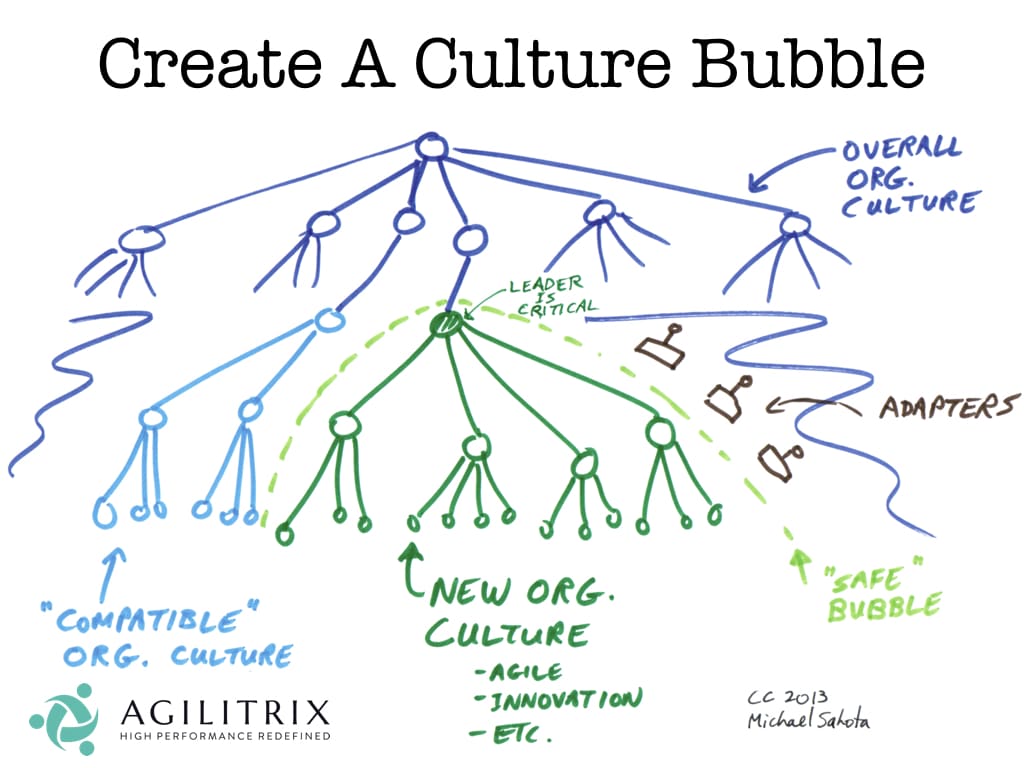7 Years ago I wrote two famous blog posts (and a book) – How to Make Your Culture Work and How to Make Your Culture Work with Agile, Kanban & Software Craftsmanship. In this blog post, you will learn my updated advice and practical experiences on exactly how to do this. The focus is on how to create the greatest success within a culture bubble while respecting the host organizational culture.
If you are interested in evolving your organizational culture, please read: How to Change Your Organizational Culture.
Culture is a Local Phenomenon
The first thing to understand is that in all organizations, culture is a local phenomenon. Some organizations have a more coherent culture while others are more diverse. Most organizations have diverse cultures or ways of working in different parts of the organization. A simple example to illustrate this is a Product Development department that has a culture focused around innovation and creating change while the Operations department has a culture focused around stability and limiting change. This typical tension birthed the field of DevOps. It’s important to realize the underlying problem is one of mismatched culture. It’s normal in organizations to have these differences and resolving them can only be undertaken through culture change. For now, let’s focus on how to work with culture gaps.

Culture Bubbles: How to Survive
The most common way that people actually succeed with Agile and other progressive approaches (Digital, Innovation, Lean, etc) in most organizations is to create culture bubbles. Most of the time this happens automatically without people even realizing it. It starts with a leader who creates a culture bubble by introduction a different way of working. What happens is that a new culture is introduced or evolves within this part of the organization. Inside the bubble there are new ways of working that are often quite different from the rest of the organization. This pattern applies at different levels of the organization: teams, groups, departments, etc.

Patterns for Unhealthy Culture Bubbles
A common pattern I have noticed is that we take actions that inadvertently reduce the health of a culture bubble. Here are the Common Traps to avoid:
- Refusing to follow processes or create artifacts needed by the rest of the organization.
- Failure to respect other groups and managers decision to work in their own way of working.
- Expecting, demanding or encouraging other parts of the organization to change.
Patterns for Healthy Culture Bubbles
Over time, I have collected a set of patterns that support a healthy sustainable Culture bubble. These are as follows:
- Create healthy relations with the rest of the organization. A sign that we are in a healthy place is that we act from this place: “We’re OK, You’re OK.” Another word to describe this is: respect.
- Build adapters around your bubble so you provide the artifacts that are needed to support the rest of the organization. The most common example from the Agile world is this: if they ask for a project plan, give them a project plan.
- Focus on growth within the bubble. Focus on developing people and their ability deliver on organizational results.
The real secret here is to focus only on what you control within your bubble. Yes, there will be constraints from outside that slow things down and limit success. And the reality is that you don’t have control over it.
A helpful metaphor is to think of all the non-value-added work for the rest of the organization as “taxes”. We all pay taxes. It’s just part of life. In organizations, we need to pay organizational taxes for the privilege of working in the organization.
You can read more details here: How to Build a Culture Bubble and Build Culture Adapters to Avoid Agile Failure.
How to Grow Culture Bubbles
Of course people are often very interested in changing things outside of their bubble. There are two common reasons for this. #1 They are so excited about their way of working, they want others to follow suit. #2 The culture of the rest of the organization is so different, that it is a burden to operate all the adapters.
Let’s look at what you have control over:
- Stuff outside the bubble: No.
- Stuff inside the bubble: Yes!
Focus on Creating a Thriving Bubble
The secret is to focus on being successful within your bubble. Build passion. Ship products. Delight customers. Be amazing.
This is 100% within your control.
Here’s what will happen over time:
- Other parts of the organization may want to emulate you. If they ask for help, then help them. This is Agile – it works on the basis of pull. Wait for people to come to you.
- The leader of the bubble will get promoted. And then the bubble can grow since this leader now has more influence.
This is a proven pattern. I have heard many examples from all over the world with exactly this happening. And graduates from my leadership training report success using these principles.
The key ingredient is that you need is patience. Evolving to a new way of working takes time. People can only change when they are ready, so it’s all about supporting them as they are ready.
Woody’s Trick to Go Faster
Woody Zuill – the thought leader introducing of Mob Programming and No Estimates – shared a trick to make the culture within the bubble spread faster: Help other people. Here is how it works. The usual thing we do is to focus on our own success even while others around us are having challenges. (That’s actually the default Scrum process.) Woody idea is this: “Hey, other people and departments are struggling. Why don’t we help them?” Instead of asking others to change their way of working, you just help them be successful. Well, guess what usually happen? The other groups notice that people are happy and engaged in the bubble. They become curious about what you are doing and how you are working. And then they want it too.

Summary for How to Make Your Culture Work
Let’s review the key messages here:
- Culture is a local phenomenon
- Grow local culture in a bubble
- Build adapters around the bubble to keep it healthy
- Pay organizational “taxes” with a sense of gratitude
- Focus on your own success
- Growth happens over time


